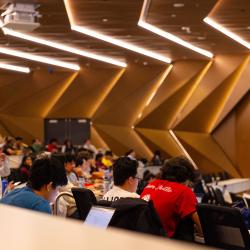Ph.D. Student Appreciates Both the Abstract Beauty and Practical Application of Math
Scales, intervals, patterns, symbols—to Sheyda Peyman, all music is math. Though to some it may seem an unlikely connection, Peyman, a Ph.D. candidate in the Applied Mathematics & Statistics, and Scientific Computation program at the University of Maryland, says the link between mathematics and music is undeniable.
“The arts and sciences all describe the same reality from different perspectives,” Peyman explained. “I’m attracted to the beauty of math and music in a truly philosophical way.”
Peyman, a vocalist, guitarist and pianist who goes by Sheyda Do’a on stage, will release her debut album in 2022. She was inspired to work on the album while an artist in residence at Strathmore, where she forged connections in the D.C. music scene.
“My music has influences from jazz and Latin music, as well as my Albanian culture,” said Peyman, who was raised in Albania. “When I’m writing my music, I don’t really have a formal process—I just get inspired in the moment, the music comes to me and I play it.”
Peyman has learned from experience that her music isn’t quite as meaningful without math in her life. After completing her bachelor’s degree in mathematics at the University of Edinburgh in 2016, Peyman attended Berklee College of Music. She spent a semester studying only music and quickly realized that she missed math—so she quit the program.
When she moved to the D.C. area in 2018, Peyman decided it was time to resume her math studies. The University of Maryland Department of Mathematics offered exactly what she was looking for.
“I’m so happy with where I’m at in my career, in both my music and in my studies at UMD,” Peyman said. “I’ve realized I need both math and music in my life.”
In her first few years at UMD, Peyman took graduate-level courses while also teaching undergraduates—earning the 2020 A. Kadir Aziz-John Osborn Graduate Student Award for her teaching skills. Now, with her qualifying exams behind her, Peyman’s research is ramping up. Her focus is network theory, which Peyman notes is a “hot topic” nowadays.
“Simply put, a network can be thought of as a set of objects and the interactions between them. The objects can be anything from people to proteins to neurons, and the interactions can be anything from emails sent to connections on social media to synapses between neurons,” Peyman explained. “Though I started at UMD doing a lot of abstract algebra, I found myself leaning more and more toward this kind of applied math. The possibilities are fascinating to me.”
Peyman is preparing to submit a paper on adversarial data contamination, which happens when data is either maliciously or accidentally altered. Consider, for example, a Facebook network of 156 vertices representing 156 people—if two of them are friends on Facebook, then there is an edge connecting the two corresponding vertices. If an adversary hacks one of the 156 accounts in the network and deletes that account’s friendships, how can that information be recovered?
“This adversary could, for example, delete a number of edges from the graph,” Peyman said. “If we have a second network that is related, we can use this information to retrieve at least part of the original network, implementing regularization techniques to help mitigate the effect of an adversary.”
In a paper written with her advisor, Mathematics Associate Professor Vince Lyzinski, Peyman proposes that network trimming should be simulated to make networks faster, smaller and more efficient—without risking network function or data loss.
With her paper wrapping up, Peyman is embarking on a new project with Lyzinski: programming an algorithm to optimize recommendations based on user inputs.
“Let’s say you’re watching Netflix. On Netflix, you can ‘like’ something you watched, and then the computer algorithm sends you recommendations based on that. Sometimes those recommendations might be wrong because the algorithm is not perfect,” Peyman explained. “We’re trying to see how we can use the information that the user inputs to give a better recommendation.”
Now in the initial exploratory phase of this new project, Peyman spends most of her time reading relevant papers and preparing to write code to apply and test her theories.
When she’s not deep in her doctoral studies, Peyman performs around the metro D.C. area and prepares for her upcoming album release. Longer term, she plans to continue pursuing her career in music while also working in applied math and programming.
“Similar to how music inspires and moves me, it’s very empowering to see a math problem, try to solve it, and then actually apply it myself to see if the results work,” Peyman said. “I’m really getting to appreciate and pursue these two passions of mine, which is why I love where I’m at right now.”
Written by Katie Bemb







